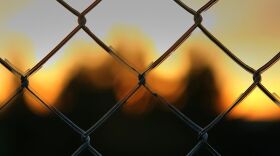Imagine that you’re in prison, and you mess up. Maybe you lose your temper and lash out at a corrections officer, or you use your fists to resolve a conflict with your cellmate.
That can land you in “administrative segregation,” also known as solitary confinement.
Too many Americans have languished in solitary, not knowing when they’ll get out and not being allowed privileges like calls from home. And when they do get out, they’re often worse off than they were before they went into solitary, full of anger and seeking retribution.
But a prison in the Upper Peninsula has found a way to change that narrative. The Alger Correctional Facility is easing prisoners out of solitary, and the results look promising.
Maurice Chammah is withThe Marshall Project. His story is titled, How to Get Out of Solitary – One Step at a Time.
According to Chammah, an estimated 80,000 to 100,000 American inmates are held in solitary confinement.
He tells us that being sent to solitary generally means you can expect to spend 23 hours a day in an isolated cell with an hour set aside for recreation.
Food is typically handed to you through a slot in the door, and “The only human contact you tend to have is with corrections officers as they shackle you to bring you out of your cell, either for recreation or for a shower,” Chammah says.
He tells us solitary confinement is used differently from prison to prison. In some prisons, he says, inmates will be sent to solitary for only a week or two as punishment for a small infraction.
“But at other prisons, including a lot at California and New York, you can go in with no idea when you’re getting out, and there are stories of people spending years, even decades in solitary confinement,” he says.
Amid lawsuits concerning the health and safety of prisoners in solitary, the Michigan Department of Corrections asked wardens around the state to come up with some ideas that would reduce the number of inmates in solitary confinement.
“Not get rid of it altogether,” he clarifies, “but just get, you know, the data to look a little bit better.
Alger’s warden Catharine Bauman and her staff up in the U.P. rose to the challenge. They developed a six-step system to help inmates work their way from solitary back to general population. It’s called “Incentives in Segregation.”
“Through good behavior and also through writing essays about their experiences, they would go from one stage to another, and at each stage they would get a perk.
Chammah tells us these perks can range from a basketball to a television in their room or even things like a phone call home.
“Over time, this has allowed them to cycle lots and lots of men out of solitary confinement and back into the general population,” Chammah says. Since its introduction in 2009, the incentive program has been so successful that it has “allowed them to close an entire wing of their solitary confinement blocks.”
Chammah tells us the project has also altered the environment of the prison. He says that visiting a prison is usually a noisy affair, with inmates shouting or throwing things to get attention from the guards, but touring the Alger facility is another story altogether.
“It’s very quiet. Even the men who are in the really brutal solitary confinement situation, because they’re trying to prove to the officers that they’re ready for general population, tend to be a lot quieter. They tend to be a lot more respectful. I heard stories of officers coming to care for the inmates and recommending books for them and sort of looking out for them in a way that was totally unique.”
Maurice Chammah’s piecefor themarshallproject.org looks at ways that prisons are trying to work prisoners out of solitary one step at a time.
He tells us more about the Incentives in Segregation program introduced in the Upper Peninsula in our conversation above.





